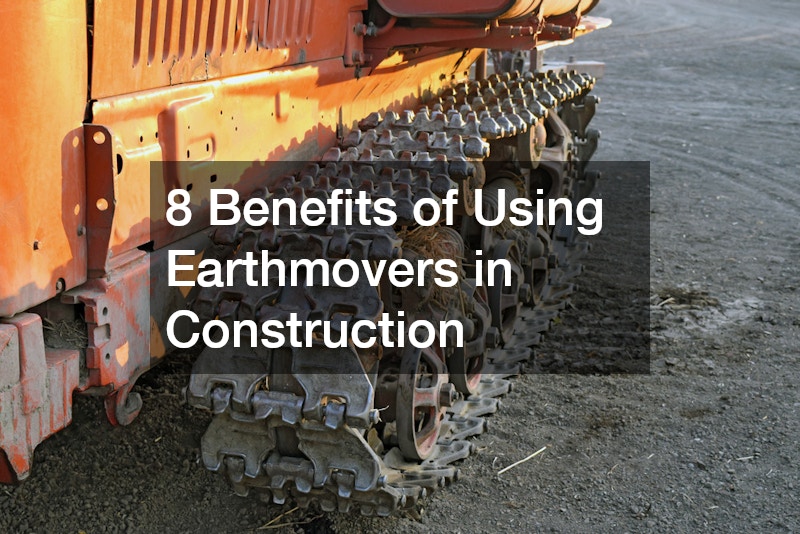In the dynamic world of construction, time, safety and efficiency are all vital. As projects grow in scale and complexity, the demand for advanced machinery continues to rise. Earthmovers play a crucial role in shaping landscapes, preparing foundations and transporting heavy materials. These powerful machines have transformed modern construction, offering a host of advantages to contractors and developers alike.
Understanding the benefits of using earthmovers in construction can help builders make informed decisions, optimise project timelines and enhance site productivity.
1. Increased Efficiency on the Job Site
One of the most significant advantages of using earthmovers is their ability to increase overall efficiency on construction sites. Manual labour, while still essential in many areas, cannot compete with the speed and force of modern machinery. Earthmovers allow teams to complete excavation, grading and transportation tasks in a fraction of the time it would take using traditional methods. This streamlined performance helps ensure that project milestones are met, contributing to faster delivery and reduced downtime. With the right equipment, even the most challenging terrains can be tackled swiftly, eliminating unnecessary delays and reducing operational costs.
2. Enhanced Precision & Control
Today’s earthmovers are equipped with sophisticated technology that allows operators to perform tasks with a high degree of precision. GPS systems, automated controls and real-time data feedback enable construction teams to dig, grade and level with accuracy previously unattainable. This level of control is especially important in projects requiring exact elevations and alignment, such as roadworks, large-scale developments and infrastructure projects. Precision reduces the need for rework, saving both time and resources while ensuring the final outcome meets strict regulatory and design specifications.
3. Improved Site Safety
Construction sites are inherently hazardous and reducing risk is a top priority for any project manager. Earthmovers help improve safety by reducing the need for manual labour in high-risk areas. Tasks such as trenching, lifting heavy materials and working on unstable ground can be completed from within the safety of a machine’s cab. Most modern earthmovers are also fitted with features that enhance operator safety, including rollover protection, high-visibility designs and ergonomic controls. The ability to automate or remotely control some equipment further minimises worker exposure to dangerous conditions, contributing to a safer working environment.
4. Versatility Across Different Applications
Earthmovers come in a variety of forms, including excavators, bulldozers, backhoes and graders, each tailored to different aspects of construction work. This versatility means that they can be used across a wide range of projects, from residential developments to major civil engineering undertakings. For example, bulldozers are ideal for clearing and grading, while excavators handle deep digging tasks. With the right attachments, many earthmovers can perform multiple functions, reducing the need to bring additional machinery on-site. This multi-purpose capability helps streamline logistics and supports more adaptive project planning.
5. Cost-Effectiveness Over the Long Term
While the upfront cost of purchasing or hiring earthmovers can be significant, their long-term benefits often outweigh the initial investment. These machines dramatically reduce the amount of manual labour required, lowering labour costs and decreasing the likelihood of injury-related expenses. Furthermore, the efficiency and speed of earthmovers reduce project timelines, which can result in substantial savings on operational overheads, equipment rental durations and financing charges. In the long run, using earthmovers contributes to more predictable budgeting and better financial outcomes for construction projects.
6. Consistent Performance in Tough Conditions
Construction projects frequently take place in environments that are difficult to navigate and subject to changing weather conditions. Earthmovers are designed to perform reliably in such settings, offering consistent output even on muddy, rocky or uneven terrain. Their durable construction and powerful engines make them suitable for the demanding nature of outdoor projects, where lesser equipment might fail or struggle to keep up. This dependable performance means work can continue regardless of external challenges, keeping the schedule on track and reducing the risk of weather-related delays.
7. Environmental Benefits Through Reduced Waste
The precision and efficiency of earthmovers also contribute to more environmentally conscious construction practices. With accurate grading and digging, the disturbance to the surrounding land can be minimised, reducing soil erosion and the unnecessary removal of vegetation. In addition, many modern earthmovers are built with fuel-efficient engines and lower emissions, aligning with sustainability goals and green building standards. Some models even incorporate hybrid or electric technologies, offering contractors environmentally friendly options that reduce carbon footprints while maintaining productivity.
8. Better Resource Management
Earthmovers support better management of materials and resources on-site. With the ability to transport soil, gravel and debris with speed and ease, these machines ensure that materials are moved only as needed, reducing double handling and waste. They also allow for better planning and utilisation of space, helping project managers maintain organised sites that operate more smoothly. In large-scale developments, where coordination is critical, the strategic use of earthmovers can make a noticeable difference in maintaining workflow and avoiding costly disruptions.
Why Earthmovers Are Essential for Modern Construction Success
The adoption of earthmovers in construction has significantly advanced the industry, providing builders with tools that enhance safety, precision and productivity. These machines are not only indispensable for large infrastructure developments but are also valuable assets in smaller-scale projects. By incorporating earthmovers into construction operations, developers can realise tangible benefits in cost savings, efficiency and environmental responsibility. As the demand for smarter, more sustainable building practices continues to grow, the role of earthmovers in shaping the future of construction remains vital.
.



